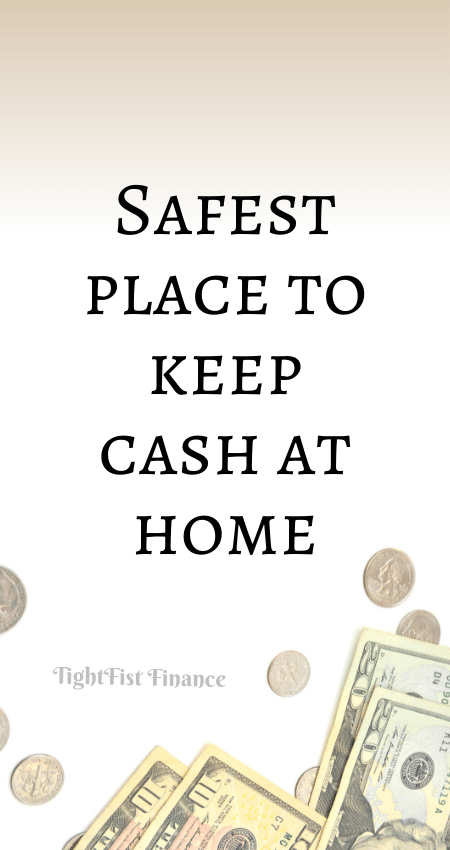Where is the safest place to keep cash at home?
Many products exist to keep valuables, like cash, safe at home. You can purchase a safe or fake electrical outlet to secure valuables. Alternatively, you can store cash behind a painting, in picture frames, the crawl space or attic, or buried outside.
Imagine, having a decent supply of cash on hand where nobody else can find it. Only you know where your cash is hidden.
Safekeeping cash is easier than you think.
Luckily for you, I’m going to show you how to keep cash safe at home. I’ll show you how much cash you should keep for emergencies, the benefits, and where to keep it.

This article may contain affiliate links which pays a commission and supports this blog. Thank you for your support!
How much cash should you keep at home for emergencies?
Most of your cash is best kept safe in a bank account, which is easily accessible for most emergencies. As a rule of thumb, you should keep no more than $500 at home which should be enough to cover most emergencies. However, you may choose to keep more at home if you live in an area stuck with frequent natural disasters.
Click to Tweet! Please Share!Click To TweetWhat are the benefits of keeping cash at home?
Keeping cash at home is beneficial for tipping delivery drivers, supporting kids fundraisers, or surviving lengthy power outages. People may also choose to keep cash at home for natural disasters like hurricanes where electronic banking may be down.
The most obvious reason for keeping cash at home is that you never know when girl scout cookies could be at your door. You wouldn’t want to pass up on thin mints because you didn’t have a way to pay.
Some people would much rather tip their delivery drivers or service workers in cash. The kid next door might offer to mow your lawn, but doesn’t have a way of taking credit cards. Cash is just convenient for minor occurrences.
However, some people live in areas struck by natural disasters. Hurricanes or Tornadoes can interrupt power, causing you to be without a way of paying for groceries. Cash provides a means of acquiring goods when electronic payments aren’t available.
Where should I keep cash at home?
There are plenty of places to keep cash at home, including a safe or fake electrical outlet. Alternatively, you can hide cash behind a painting, picture frame, in your crawl space or attic, or even buried outside.
Safe
A safe is one of the best places to keep your money. After all, safes are designed to keep people out and they’re often heavy enough to avoid moving. You can share the combination with your close friends and family to allow them access at any time.
The main downside is that safes are often expensive. Prices range from $60 all the way up into the thousands. Cheaper safes are lighter, which means someone could carry the safe away.
Fake electrical outlet
Installing a fake electrical outlet isn’t overly difficult and can be a good spot to hide cash. These outlets blend into your home and most people won’t know it’s fake. The only people who might discover it are those who spend enough time in your house to plug something in.
Burglars are often looking for common cash hiding spots, like under your mattress. Finding cash in your dresser drawer is much easier and more common than in a fake outlet. Therefore, most burglars won’t find fake electrical outlet cash or valuables.
Behind a painting
Some people hide their cash in an envelope which is then taped to the back of a painting. Paintings are a good spot to hide your cash because they’re rarely moved. However, cash can be discovered if the painting is knocked off or if a thief trashes your place.
Picture frames
Hiding your cash behind pictures in a picture frame is typically a safe place to store cash. Most picture frames are undisturbed, making them a perfect place to hide cash. Just make sure you don’t forget that you left the cash behind the pictures.
Crawl Space or Attic
Nobody likes to go into the crawl space or attic of your home, which makes it the perfect place to hide cash. The only people who go into crawl spaces or attics are usually your HVAC repairman or plumbers.
Make sure you secure your cash in a box which protects the contents from the environment. Crawl spaces and attics are not temperature or humidity controlled, which can damage the cash.
Buried outside
Some people build underground boxes or pipes for storing items. These items have a cap or lid which is covered with sod, so it blends in with your yard. Just make sure the box or pipe is adequately sealed to protect your cash from the wet environment.
Click to Tweet! Please Share!Click To TweetSummary: Safest place to keep cash at home
As you can see, it can be beneficial to keep up to $500 in cash at home. You may choose to keep more cash if you live in an area with natural disasters. Most people should keep their cash in the bank, but having some cash on hand is good for emergencies.
People keep cash at home for quick payment opportunities, like tipping drivers or paying service workers. Cash at home also comes in handy for extended power outages which might cause payment systems to go down.
The best products to store cash include safes and fake electrical outlets. Alternatively, you can store cash buried outside, in a crawl space or attic, or behind a painting or picture frame.